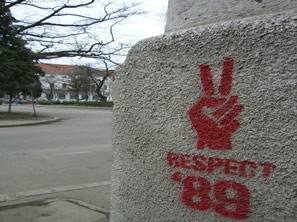In Bryant's Footsteps: Translating Nicaragua's Cardenal
Jonathan Cohen is a translator of Spanish American poets. He has translated Ernesto Cardenal (With Walker in Nicaragua and Other Early Poems; From Nicaragua, With Love; Zero Hour and Other Documentary Poems), Enrique Lihn (The Dark Room and Other Poems), Roque Dalton (Small Hours of the Night), and Pedro Mir (Countersong to Walt Whitman), receiving the Robert Payne Award, an NEA Translation Fellowship, and ALTA's Outstanding Translation-of-the-Year Award. His most recent publiscation is A Pan-American Life: Selected Poetry and Prose of Muna Lee.
I want to start by explaining the first half of the title of my presentation, “In Bryant's Footsteps.” Here I am referring to the long tradition of socially committed translation initiated by William Cullen Bryant, the great U.S. poet, translator, journalist, patron of writers and painters, and newspaper publisher, whose life spanned most of the 19th century. Specifically, I am referring to Bryant's work as a translator of contemporary Latin American poetry that gave voice to the national struggles for independence throughout Spanish America during the 19th century. It was Bryant who in the 1820s translated the exiled Cuban poet, José María Heredia, and who throughout his long career was committed to social justice and the art of translation. Bryant would publish his translations of Latin American poets—mostly authors of political poetry—in his daily newspaper, the New York Evening Post. He also published translations in the literary journals he edited, and, like Longfellow, in widely read anthologies.
In fact, it was William Cullen Bryant who founded the U.S. literary tradition of translating Latin American poets and, in particular, of giving voice to a genre of poetry that aimed to be useful in the national struggles for independence from Spain during the 19th century, and then largely from the United States during the 20th century—that is, from U.S.-supported dictatorships in the service of the United Fruit Company, the Anaconda Mining Company, or other U.S. self-interests, both commercial and political.
Following Bryant, other translators—mostly poets—have kept this Pan-American literary tradition alive, in English, for nearly two centuries. Going back in time, there was William Henry Hurlbert, who in the mid-19th century promoted and translated contemporary Spanish American poets, including Heredia and another Cuban poet, known as Plácido, an Afro-Cuban poet executed for taking part in a slave revolt. There was Muna Lee, whose commitment to the cause of Pan-Americanism and to the cause of feminism led to her doing the landmark “Spanish-American number” of Poetry magazine in 1925. There was Alice Stone Blackwell (daughter of abolitionist and feminist Lucy Stone), who was committed to translating the poetry of oppressed peoples and whose 1929 Some Spanish-American Poets was a landmark publication. There was Langston Hughes, who translated the Cuban poet Nicolás Guillén in the 1930s and 40s. There was H. R. Hays, the leftist-surrealist poet who in 1943 published his famous 12 Spanish American Poets. And there was Waldeen, the prima ballerina who in the late 1940s translated Neruda's “Let the Rail Splitter Awake,” which was widely read during the 50s, and which introduced a new generation of U.S. poets to what Allen Ginsberg called the “expansiveness” of Neruda's voice.
Recent decades—the years since the 1960s—have witnessed growing numbers of U.S. translators of Latin American poetry as well as fiction—who have established Latin American literature in English translation as a major component of American literature, that is, U.S. literature. Of course, translators made the so-called Boom happen in the 60s and 70s.
The second half of the title of my presentation, “Translating Nicaragua's Cardenal,” brings us up to me. Here I am referring to my work as a translator of Nicaragua's greatest living poet, Ernesto Cardenal, a Christian-Marxist Catholic priest. I started this work in 1970—I was 20 years old, and he was 45. My first project was making a translation of his recently published book, Oración por Marilyn Monroe y otros poemas (Prayer for Marilyn Monroe and Other Poems). I sent a copy of my translation to Cardenal in Nicaragua. He liked it a lot. This led to an active correspondence with him and to a lasting friendship and close working relationship with him. In the mid-1970s, I traveled to Nicaragua to spend a month with him at his famous commune that was located on a remote island in Lake Nicaragua, and also to experience along the way many of the things in the poems of his I was translating: the heat, the disparity between the rich and the poor, the red silhouettes of the volcanoes at dusk, the odors of the streets in Managua, the expressions on the faces of the people in the streets.
At that time, Cardenal was actively writing protest poetry that he invited me to translate into English. Often the protest was against the long history of U.S. intervention in the social and political life of Nicaragua. I became increasingly politicized by the act of translation—through my critical reading of the original texts and through my study of Nicaraguan history that was central to Cardenal's poetry. I knew I was giving an American English voice to a Spanish American voice that needed to be heard in the United States—the voice of an entire people—to gain empathy for their suffering under a U.S.-sponsored dictatorship, namely, the dictatorship of Anastasio Somoza, whom Cardenal once called “one 40-year-long earthquake.”
In the early 1980s, I translated Cardenal's “With Walker in Nicaragua.” Originally composed in 1950, this long narrative poem depicts the history—through memoirs of the poem's persona—of the mid-19th century invasion of Nicaragua by a U.S. mercenary named William Walker, from Tennessee. The poem begins this way:
In a lonely cabin on the frontier,
I, Clinton Rollins, attempting no literary style,
pass the time by penning my memories.
And as an old man my thoughts wander back:
The things that happened fifty years ago . . .
Spanish-Americans I have known
—whom I have grown to like . . .
And that warm, sweet, green odor of Central America.
And here's the portrait of William Walker that the gringo speaker of the poem presents:
I saw Walker for the first time in San Francisco:
I remember him as if I were seeing his blond face like a tiger's;
his grey eyes, without pupils, fixed like a blind man's,
but which expanded and flashed like gunpowder in combat,
and his skin faintly freckled, his paleness, his clergyman's ways,
his voice, colorless like his eyes, cold and sharp,
in a mouth without lips.
And a woman's voice was hardly softer than his:
that calm voice of his announcing death sentences . . .
that swept so many into the jaws of death in combat.
He never drank or smoked and he wore no uniform.
Nobody was his friend.
And I don't remember ever having seen him smile.
This translation project, which I initiated myself, led to a nice translation fellowship from the National Endowment for the Arts, and then to our book, With Walker in Nicaragua and Other Early Poems (1949-1954), which we published in 1985.
A socially committed translator like myself could not ask for more than the review of this book that appeared in the Washington Post. It was the lead review on page 1 of the book review section. Not only did the reviewer, Robert Hass, say that my translation was “brilliant”—”so good you feel that the poems might have been written in English”—he stated—and this was more important: “It occurs to me to say by way of introduction to his [Cardenal's] work, that if Americans are going to pay taxes to support a war against his country [that is, the so-called Contra War of Ronald Reagan], they ought at least to have the decency to read his books, in order to learn something about one of the visions that underlies revolution in Central America.”
There was great public interest in this book, in particular, the 19th-century history remembered in the title poem and other poems. I was motivated to direct a stage adaptation of the title poem. After that, I directed Ed Asner in a reading of this poem for a half-hour program that was aired on National Public Radio. My translation was getting a lot of attention, and I had expanded it into the realm of theatre. There I furthered the process of translation. All the while I was working on translations of Cardenal's new poems that he sent me by way of diplomatic pouch so that the U.S. postal system couldn't tear open my mail from Nicaragua. In 1985, he and I did a reading together at New York University in a large recital hall jam-packed with hundreds of people. This event was like a rock concert, with cheers for these poems that we read in Spanish and in English. Nicaragua's voice in its struggle for freedom was being heard loud and clear, at least in this recital hall. City Lights then published Cardenal's book, From Nicaragua, With Love: Poems (1979-1986), with my translations.
To sum up: m y recognition of the long U.S. literary tradition of the socially committed translation of Latin American poetry—the tradition I briefly described earlier—was very important to me, personally, because my awareness of this tradition helped to validate my own solitary activity as a translator. More than that, it was an inspiration to contribute to this great literary tradition, and to further it in the company of my fellow translators doing the same. Concerning translation and social commitment, I learned that social commitment alone doesn't make good translations, just as social commitment alone doesn't make good literature. Good translations of poetry, for instance, require literary skills, plus critical skills. I also learned that translation offers a meaningful way of giving to others and of contributing to struggles for a better world “with liberty and justice for all.” Translation can take part in social change. I learned that the translation of certain works from nations in conflict with the United States—from love songs to protest poems—becomes a necessary political act in the fulfillment of the destiny of these literary works. The translation of such literature creates a bridge to empathy, which most often is required for progress to be made toward the resolution of international conflicts. Above all, I learned that translation is one of the essential instruments of cultural exchange that may help to prevent, or limit, these conflicts.



